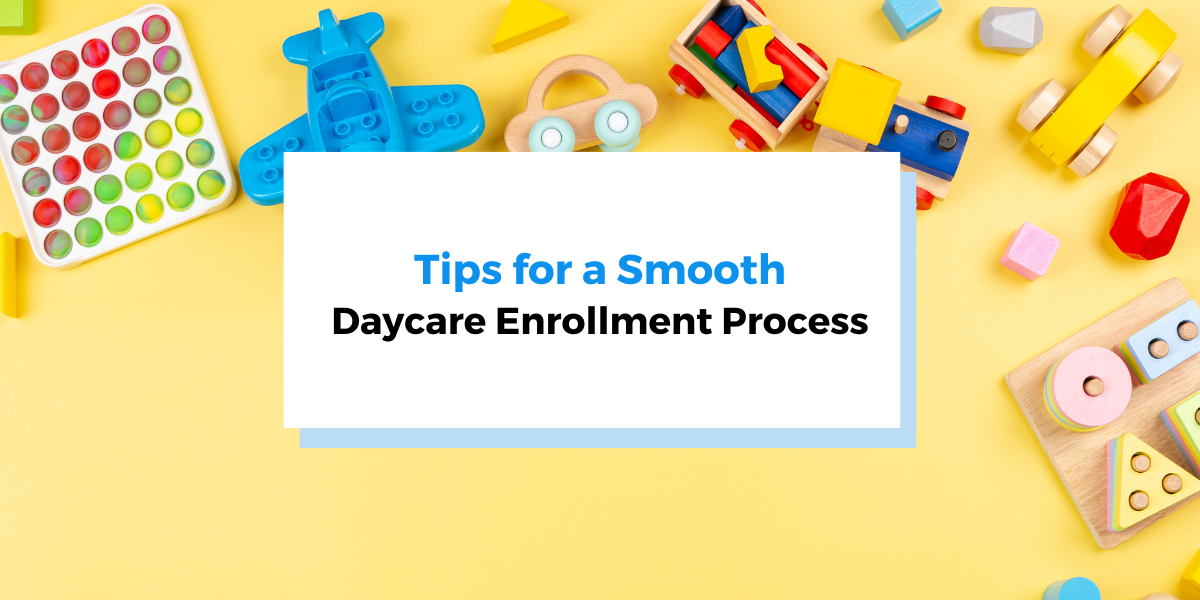As an educator, it can seem a little out of your wheelhouse to think of “marketing”.
But creating a thriving learning community takes effort, and that effort includes promoting your school to prospective students.
In other words, to attract new students, you need an enrollment marketing plan.
Enrollment marketing focuses on attracting, engaging, and enrolling students through innovative and cross-channel experiences for students and their parents.
In this post, we’ll cover six actionable marketing strategies for connecting with your target audience, elevating brand awareness, and increasing your school’s enrollment.
- 1. Build a Great Reputation
- 2. Optimize Your Website for Mobile Devices
- 3. Increase Website Traffic Using SEO
- 4. Use Social Media to Market Your School
- 5. Make Use of Email Marketing Strategies
- 6. Use Paid Online Ads to Market Your School
- Drive Up Your Student Enrollment With These Marketing Strategies
1. Build a Great Reputation
First, don’t underestimate the power of your school’s reputation in increasing student enrollment.
If the public perceives your school positively, you can obtain endorsements to help bolster your attractiveness to new and prospective students.
These endorsements can come from several places—including community leaders, news articles, as well as current and past students.
Your school can and should have a positive reciprocal relationship with the surrounding community.
Research shows that the presence of a university leads to increased employment and higher earnings across the local economy.
And since research universities drive innovation and economic growth, many large companies are also drawn to college towns and nearby vicinities—which leads to even more economic growth in the area.
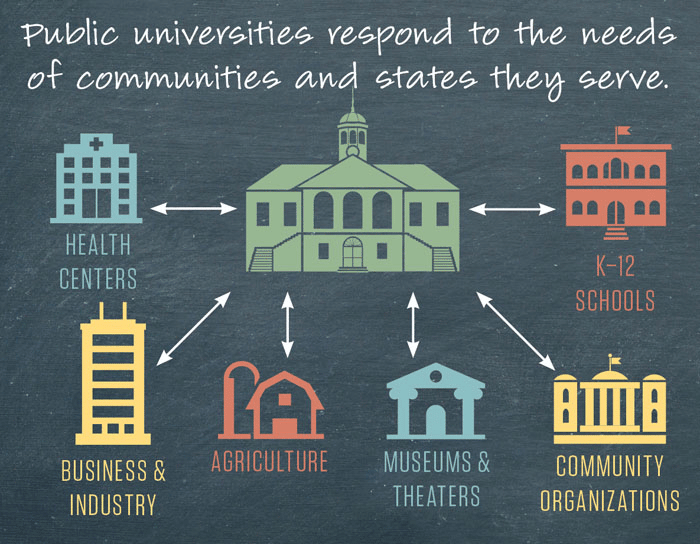
If your school fosters a positive relationship with your local community, you benefit by creating a thriving place for students and faculty to live.
Best practices include hosting events and communities on the school grounds, such as:
- Concerts and performances
- Blood drives
- Farmers markets
- Advocacy group meetings
- Support groups
- Volunteer organizations
- Nonpartisan voting initiatives
You can also improve enrollment management by creating professional opportunities and internships for your students with local companies.
The better your standing in your local community and school district, the easier it will be to attract students from that community.
Another way to build your reputation and improve your marketing efforts is to stay in touch with alumni and graduate students. Endorsements from former students, especially highly successful ones, can motivate potential students to enroll.
These real stories from real-life former attendees are social proof that goes a lot further with potential students than any hypotheticals and promises you can make.
2. Optimize Your Website for Mobile Devices
Teenagers and college applicants today use their phones for everything.
In fact, recent statistics on Gen Z reveal that 3 out of 4 teenagers would rather use their smartphone than a desktop computer.
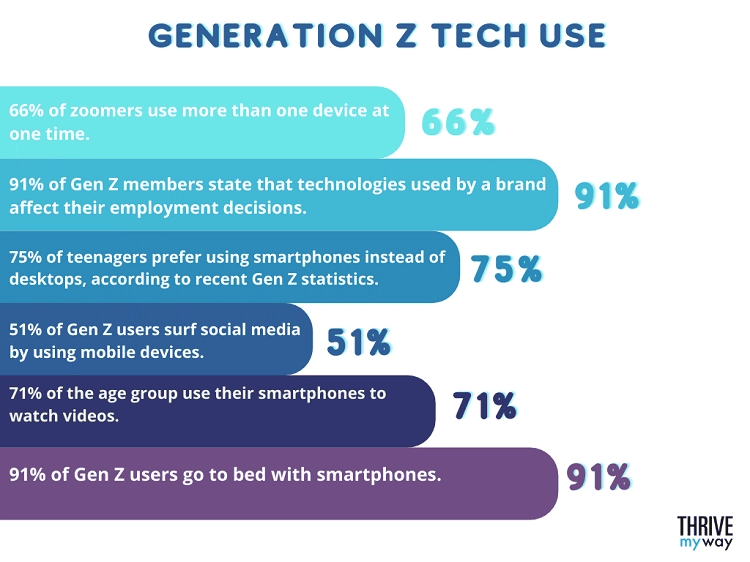
Source: Thrive My Way
Younger generations are proficient mobile device users and they prefer using their phones for everything from checking email and social media platforms to watching videos, even doing homework.
So, if you want to appeal to today’s college-age students within your strategic plan, you need to keep mobile devices in mind.
A website that loads slowly or that breaks, when displayed on a smaller screen, can give the impression that your school is unprofessional and behind the times.
Beyond your site, you should also provide convenient and satisfying user experiences for all of your marketing channels, applications, and communication processes.
Prospective students should be able to peruse your marketing materials, watch promotional videos, fill out forms, view academic programs, and communicate with you from their phones and tablets.
If the experience of interacting with you is difficult and antiquated, prospective students will assume that’s what it’s like to attend your institution, too.
With these organizational skills in mind, it’s easy to see how the mobile-friendliness of your consumer-facing materials can have a direct impact on your conversion and enrollment rates.
A 2021 study by Text Anywhere found that the global average open rate of SMS is 95%.
Therefore, reaching out to prospective students with a well-timed and engaging text makes it more likely that they’ll take the next step to apply.

Your Courses Matter, So Does Your Cash Flow
See How Efficient Registration Affects Cash Flow!
3. Increase Website Traffic Using SEO
While you might assume the only way to reach teens and young adults is through social media, 64% of prospective college students would rather learn about your school through website copy and blog articles.
Optimizing your website to rank in a Google search—and then be imminently readable by visitors who click through—is a great strategy for reaching more students during the decision-making process and achieving your enrollment goals.
Optimize your organization’s website for search engines to help drive organic traffic to your site and rank higher in search results.
One marketing tactic to make your school more discoverable in your area is to focus on optimizing your site for local searches.
Many older students want to attend classes close to home, while teens going to school for the first time may want to choose a school in a new and exciting part of the country.
Either way, prospective students will likely use location-based search terms like “colleges in Chicago” or “online school Atlanta.”
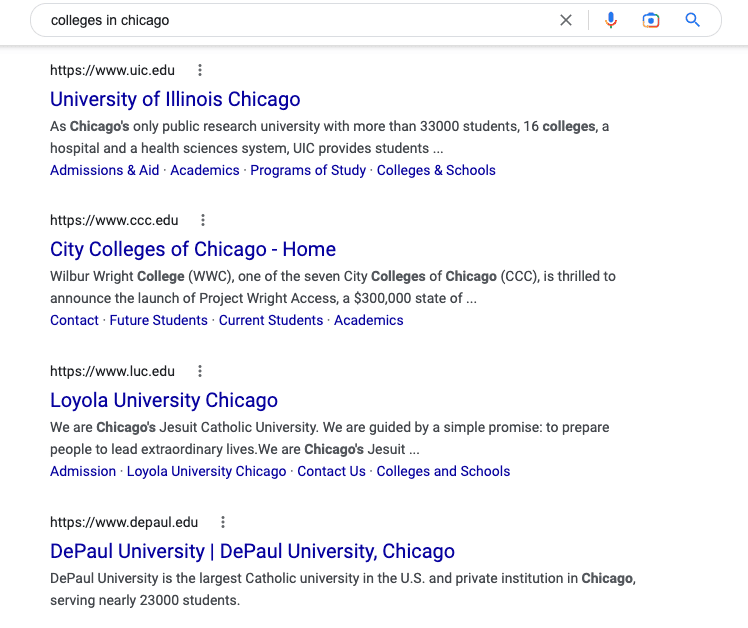
Source: Google
As you can see from the search results, four of the top schools in the Chicago area have optimized their site to rank at the top of Google’s search engine results page (SERP).
But Northwestern University, another highly reputable college, doesn’t appear on the first page at all.
Can you guess which school did not bother to optimize for local search?
Creating engaging and high-quality content can help your school’s website increase in domain authority and rank consistently higher in search results.
But beyond simple rankings, written content like long-form blog articles, ebooks, and other written resources should be added to your strategic planning to help persuade future students that your school is the right choice for them.
4. Use Social Media to Market Your School
Social media is popular with all generations, but especially teens and young adults, which is precisely the demographic you should be looking at.
Crafting an engaging social media content strategy can keep you front of mind with your target audience, increase conversion rates, and help you reach your marketing goals.
When promoting your school on social channels, start small. You don’t want to overstretch your resources by managing a social campaign on multiple social media sites.
And even worse, you don’t want to start several profiles just to let most of them go dormant a few weeks later once you get overwhelmed.
As school marketing expert Ellie Diamond writes for Constant Contact:
When you’re new to social media marketing, it’s hard to juggle several platforms several at once. Start by focusing on one, then expanding once you’ve got the hang of it.
Choose just one platform to focus on at first—and make it one that your target audience uses.
Facebook and Instagram are excellent choices for beginner school marketing teams since both are widely used by both teens and adults.
Facebook saw an average of 2.9 billion monthly active users worldwide as of January 2022, while Instagram saw nearly 1.5 billion.
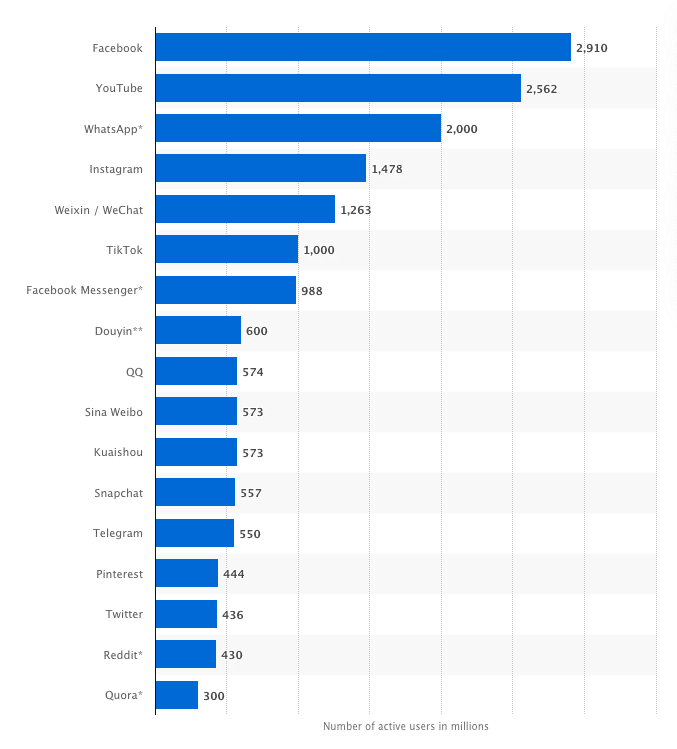
Source: Statista
What kind of content should you post on social media?
For best results, your social feeds should be a mix of original and user-generated content. Original posts could feature:
- Images and videos of school activities
- Campus updates
- Flyers for upcoming events
- Reminders of important dates (like application or tuition deadlines)
You could also invite engagement by featuring groups, students, or faculty who deserve congratulations.
Posting a photo of your championship-winning soccer team on Instagram encourages your followers to post their own congratulatory messages and even share the post with their own followers.
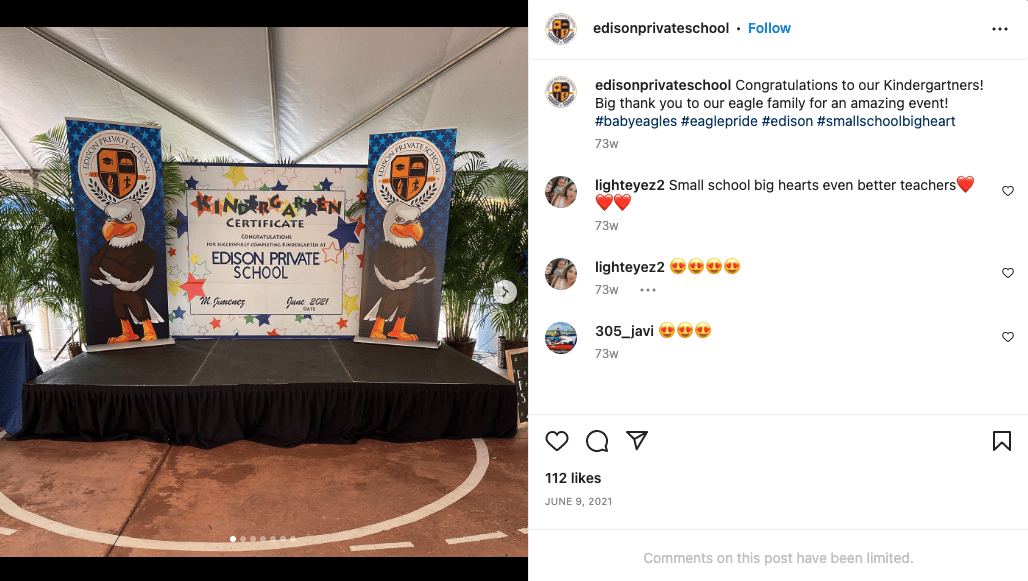
Source: Edison Private School on Instagram
User-generated content, or UGC, is created by your target audience (in this case, current or prospective students, faculty, and alumni).
You can bolster your engagement levels on your social profiles by sharing and reposting content from others in your sphere.
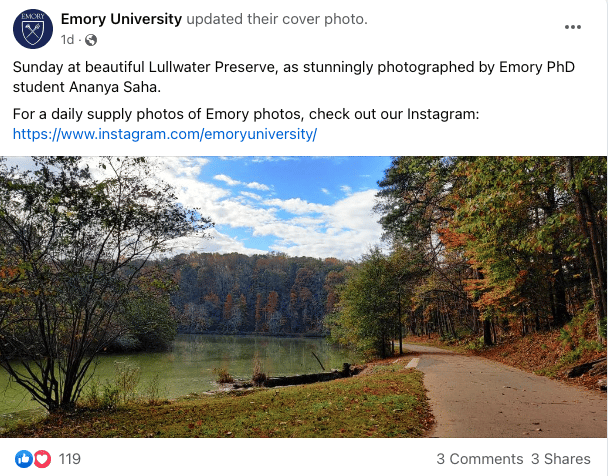
Source: Emory University on Facebook
The best UGC for increasing audience engagement includes:
- Authentic photos and videos from student life
- Feedback and comments from students, parents, and teachers
- Reviews and testimonials
One way to encourage UGC is to use a branded hashtag for significant events like games and festivals.
As attendees post on social media with the hashtag, you can easily aggregate the best posts and share or repost them (with the proper attributions, of course) for your larger audience.
You might be surprised at the level of creativity you’ll see from student and faculty posts.
User-generated marketing content kills two birds with one stone by relieving some of the burdens of content creation while also showing prospective students what campus life is really like.

Course Registration That Gets You Paid On Time, Every Time
Increase Your Cash Flow By 35%!
5. Make Use of Email Marketing Strategies
Email can be a powerful marketing tool for schools looking to increase student enrollment.
Social media might be flashy, but email isn’t going anywhere.
In fact, it is estimated that by 2025, the number of email users worldwide will reach 4.6 billion—and 376 million emails will be exchanged daily.
Therefore, your digital marketing strategy should include email campaigns.

Source: Statista
Of course, for best results, you should avoid making common email marketing mistakes like neglecting to personalize or segment your emails.
The latter of the two, segmentation, is the process of dividing up your email list into groups—e.g., prospective students, current students, parents, faculty, alumni, etc.
And you can even get more granular by segmenting your list of prospects into subgroups like:
- Expected major
- In-state and out-of-state
- Hobbies and interests
The more specific your email segmentation, the easier it is to send relevant, interesting content to exactly the right people who can benefit the most from it.
And you’ll avoid overloading your whole email list by sending every email to everyone on it—which is a recipe for mass unsubscribing.
Automation technology can save your marketing team a lot of time and maximize engagement.
For example, with Regpack, you can set up trigger-based automations to email recipients when certain actions are taken.
The next time a prospect signs up for your email newsletter, rest assured that they’ll receive a warm welcome email.
6. Use Paid Online Ads to Market Your School
If your school has a budget for paid online advertising, this marketing strategy is an excellent way to make your institution visible to your target students.
But since pay-per-click (PPC) ads require an upfront investment, make sure to start with very clear goals.
As the Higher Education Marketing blog puts it:
Paid ads can meet any number of objectives, from specific goals like encouraging international students to attend your webinar, to broader targets such as improving brand visibility, to arguably the most important goal of all – increasing inquiries and applications. The goals you set influence who you aim to reach, which platforms you use, and how you measure your progress.
Also, make sure you have a detailed description of your target student.
Paid ads on social media use targeting algorithms that display your ads to the best demographic match, such as location, age, and interests.
Paid ads on search engines, on the other hand, rely more on targeted keywords—which means you need to have a good understanding of the topics and phrases your ideal audience is searching for.
Regardless of which platform you choose, targeted online advertising can be an effective method for your school to widen its reach and make itself known, which can increase student enrollment.
Drive Up Your Student Enrollment With These Marketing Strategies
Implementing an enrollment marketing strategy is the key to building a flourishing and vibrant educational community.
Show prospective students the benefits of attending your educational institution by first building a positive reputation within your community.
Solicit authentic endorsements from area business owners, community leaders, and former students.
Then, turn to digital marketing strategies. Start by optimizing your website for mobile devices and for search engine rankings—that way, you’ll maximize visibility and engagement.
Pair compelling website content with winsome social media content, paid online ads, and email marketing techniques, and you’ll start seeing positive results in no time.
To learn more about maximizing student enrollment at your institution, check out our article here: 5 Ways for Schools to Offer More Value to Students.

Course Registration Shouldn’t Be Complex
Simplify Your Process, Raise Your Cash Flow!





